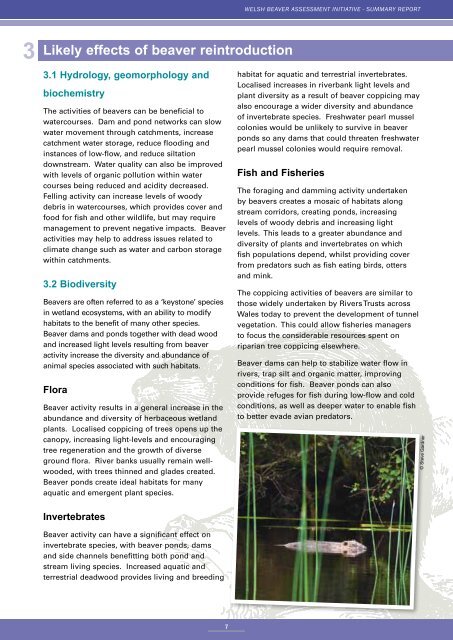Beaver-Summary-report-English
Beaver-Summary-report-English
Beaver-Summary-report-English
You also want an ePaper? Increase the reach of your titles
YUMPU automatically turns print PDFs into web optimized ePapers that Google loves.
3<br />
Likely effects of beaver reintroduction<br />
3.1 Hydrology, geomorphology and<br />
biochemistry<br />
The activities of beavers can be beneficial to<br />
watercourses. Dam and pond networks can slow<br />
water movement through catchments, increase<br />
catchment water storage, reduce flooding and<br />
instances of low-flow, and reduce siltation<br />
downstream. Water quality can also be improved<br />
with levels of organic pollution within water<br />
courses being reduced and acidity decreased.<br />
Felling activity can increase levels of woody<br />
debris in watercourses, which provides cover and<br />
food for fish and other wildlife, but may require<br />
management to prevent negative impacts. <strong>Beaver</strong><br />
activities may help to address issues related to<br />
climate change such as water and carbon storage<br />
within catchments.<br />
3.2 Biodiversity<br />
<strong>Beaver</strong>s are often referred to as a ‘keystone’ species<br />
in wetland ecosystems, with an ability to modify<br />
habitats to the benefit of many other species.<br />
<strong>Beaver</strong> dams and ponds together with dead wood<br />
and increased light levels resulting from beaver<br />
activity increase the diversity and abundance of<br />
animal species associated with such habitats.<br />
Flora<br />
<strong>Beaver</strong> activity results in a general increase in the<br />
abundance and diversity of herbaceous wetland<br />
plants. Localised coppicing of trees opens up the<br />
canopy, increasing light-levels and encouraging<br />
tree regeneration and the growth of diverse<br />
ground flora. River banks usually remain wellwooded,<br />
with trees thinned and glades created.<br />
<strong>Beaver</strong> ponds create ideal habitats for many<br />
aquatic and emergent plant species.<br />
Invertebrates<br />
<strong>Beaver</strong> activity can have a significant effect on<br />
invertebrate species, with beaver ponds, dams<br />
and side channels benefitting both pond and<br />
stream living species. Increased aquatic and<br />
terrestrial deadwood provides living and breeding<br />
7<br />
WELSH BEAVER ASSESSMENT INITIATIVE - SUMMARY REPORT<br />
habitat for aquatic and terrestrial invertebrates.<br />
Localised increases in riverbank light levels and<br />
plant diversity as a result of beaver coppicing may<br />
also encourage a wider diversity and abundance<br />
of invertebrate species. Freshwater pearl mussel<br />
colonies would be unlikely to survive in beaver<br />
ponds so any dams that could threaten freshwater<br />
pearl mussel colonies would require removal.<br />
Fish and Fisheries<br />
The foraging and damming activity undertaken<br />
by beavers creates a mosaic of habitats along<br />
stream corridors, creating ponds, increasing<br />
levels of woody debris and increasing light<br />
levels. This leads to a greater abundance and<br />
diversity of plants and invertebrates on which<br />
fish populations depend, whilst providing cover<br />
from predators such as fish eating birds, otters<br />
and mink.<br />
The coppicing activities of beavers are similar to<br />
those widely undertaken by Rivers Trusts across<br />
Wales today to prevent the development of tunnel<br />
vegetation. This could allow fisheries managers<br />
to focus the considerable resources spent on<br />
riparian tree coppicing elsewhere.<br />
<strong>Beaver</strong> dams can help to stabilize water flow in<br />
rivers, trap silt and organic matter, improving<br />
conditions for fish. <strong>Beaver</strong> ponds can also<br />
provide refuges for fish during low-flow and cold<br />
conditions, as well as deeper water to enable fish<br />
to better evade avian predators.<br />
© Steve Gardner


